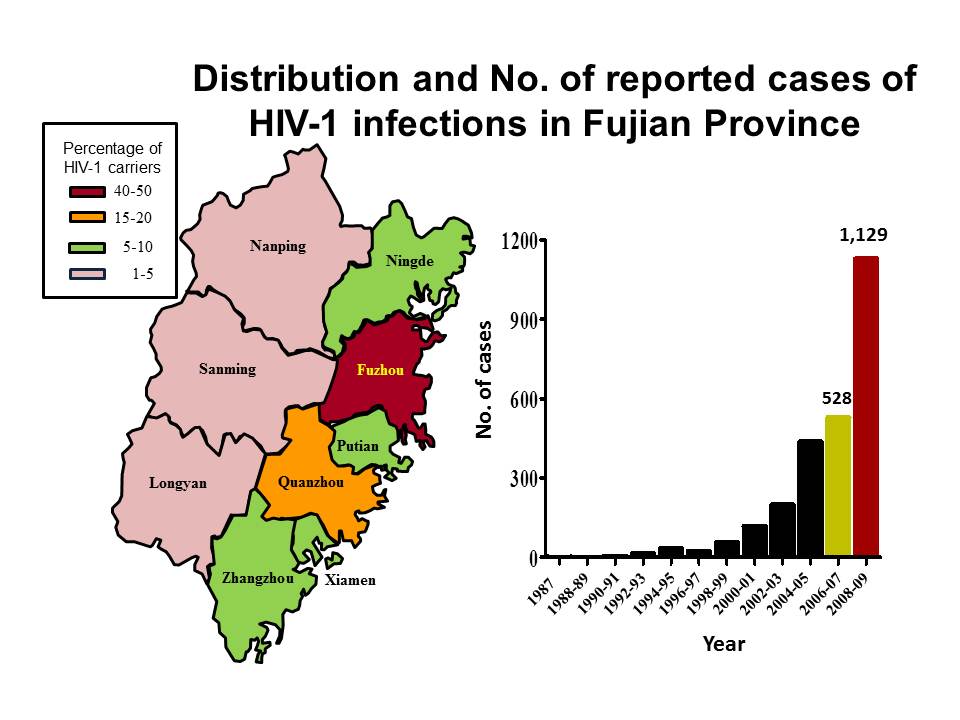Media
HKU reports the spread of HIV-1 infections with an increased speed among general populations of China’s Fujian province
13 Mar 2012
Asia contains over half of the world's human population. To prevent a worsened AIDS pandemic, it is essential to monitor the spread of HIV-1 among Asia's general populations. Till now, most studies in China focused on high prevalent regions such as Yunnan and Henan provinces. Few reports studied low prevalent regions. In the past three years, scientists at the AIDS Institute of The University of Hong Kong Li Ka Shing Faculty of Medicine conducted the first province-wide epidemiological and molecular epidemiological study of HIV/AIDS in Fujian province, in collaboration with Fuzhou Centre for Disease Control and Prevention and Fujian Centre for Disease Control and Prevention. The study revealed a rising epidemic of HIV-1 infections among general populations in this low prevalent region. The number of identified cases has doubled from 528 in 2006-2007 to 1,129 in 2008-2009. The findings provide critical information for a better understanding of HIV/AIDS in China. The complete research report has recently been published in Journal of Acquired Immune Deficiency Syndromes.
Research Background and Methods
In China, the number of people who live with HIV-1 has exceeded over 780,000 while 154,000 of these cases have developed AIDS. Heavily affected regions include Yunnan, Guangxi and Henan provinces. Most cases in Yunnan and Guangxi resulted from infections of HIV-1 CRF08/07_CB' subtype primarily among intravenous drug users followed by increased sexual transmissions of CRF01_AE subtype in recent years, whereas infections in Henan were dominated by B' subtype due to un-sanitized paid blood donations.
Fujian is adjacent to Taiwan Strait with active economic activities, and is considered as a low prevalent region of HIV-1 infections. Hong Kong's 1/6 population are originated from Fujian clans. The study investigated over three million samples collected between 2006 and 2009 in Fujian by serological and genetic analysis.
Results
The study reports that the number of HIV-1 infections has doubled from 528 in 2006-2007 to 1,129 in 2008-2009 as confirmed by testing. Despite the enhanced efforts of surveillance, it is surprising to find that there are a proportional elevated number of infections, together with significantly increased rates of prevalence. The findings reveal a previously unrecognised hidden epidemic characterised by rapidly rising number of HIV-1 infections. Moreover, the spreading HIV-1 strains have expanded from the dominant CRF01_AE subtype to multiple genotypes together with emerging drug resistant viral variants, suggesting that Fujian had experienced multiple HIV-1 introductions.
The study discovers that the significantly increased rates of prevalence are among blood donors, blood recipients, pregnant women and pre-surgical patients, suggesting that HIV-1 infection has attacked general populations significantly in Fujian. Accordingly, significantly increased proportions of infections are found closely related to both heterosexual and homosexual transmissions (increased from 53.4% in 2006-2007 to 71.3% in 2008-2009). In particular, the percentage of homosexual transmissions rose from 1.9% to 5.3%. These findings indicate that unprotected sexual behaviour might have resulted in a new wave of HIV-1 spread with an increased speed among general populations in Fujian.
Another characteristic of the epidemic is the finding of high proportions of infections among people unemployed and people aged above 40 years. However, it remains to be determined whether or not this finding is related to the economic crisis around 2007 although the study depicted the heavily affected prefectures along the costal economic zone in Fujian. Researchers believe that the findings warrant future investigation of the impact of the economic crisis on the HIV-1 epidemic, such as whether the economic downturn drives more people to engage in prostitution.
Research Implications
Dr CHEN Zhiwei, the corresponding investigator of the study and Director of AIDS Institute of The University of Hong Kong Li Ka Shing Faculty of Medicine emphasises that "Unprotected sexual contact is the major mode of HIV-1 transmission among general populations. Since the epidemic remains largely hidden, the increased prevalent rate of infection among general populations posts a new challenge to our national efforts in the fight against HIV/AIDS. HIV-1 surveillance and prevention, therefore, should be immediately enhanced in low prevalent regions besides the efforts in high prevalent regions. We must improve our surveillance and prevention by building up a transparent data collection and sharing system as well as a reliable method to evaluate the efficacy of our preventive measures. Our findings are critical for Fujian to build a comprehensive HIV-1 prevention programme". He adds, "China hosts one of the largest populations in the world. The control and elimination of HIV-1 sexual transmission among general population would have significant implications for preventing a larger epidemic in China or a growing pandemic in the world. "
The AIDS Institute of The University of Hong Kong Li Ka Shing Faculty of Medicine will continue to study the spread of HIV/AIDS in China, particularly the new infections and transmissions of HIV-1 in the unemployed and men who have sex with men (MSM).

